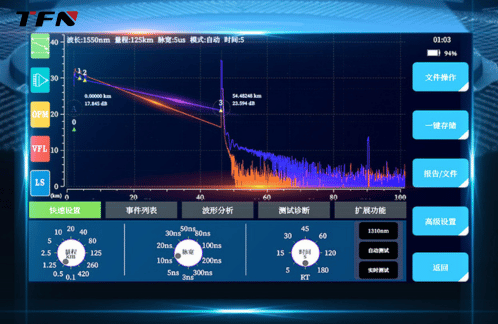How does the optical time domain reflectometer achieve PON online testing?
The optical time domain reflectometer (OTDR) is a precise optoelectronic integrated instrument made by using the backscattering generated by Rayleigh scattering and Fresnel reflection when light is transmitted in the optical fiber. It is widely used in the maintenance and construction of optical cable lines, and can measure the fiber length, transmission attenuation of the optical fiber, joint attenuation and fault location. The optical time domain reflectometer is often used for the measurement of long-distance optical communication systems (active optical fiber). Online testing in passive optical networks (PON) is challenging for the following reasons:

The signal in the passive optical network is transmitted through passive distributed optical fiber, and there is no relay equipment or optical amplifier to process or enhance the signal. Therefore, it is difficult to actively operate and monitor the signal during online testing.
Since passive optical networks do not have relay equipment or optical amplifiers, signals may be affected by signal attenuation, dispersion, etc. during transmission, resulting in a decrease in signal quality. It is difficult to accurately measure the quality and performance of signals during online testing.
Since signals in passive optical networks are transmitted passively, it is impossible to adjust and correct signals in real time. Therefore, it is difficult to identify and adjust network problems in real time during online testing.
With the continuous maturity of PON online testing technology and the increasing market demand for reliability and ease of use of field testing equipment in the laying and maintenance of optical fiber networks, many devices support PON online testing functions. The implementation of PON online testing mainly includes the following steps:
Choose the right wavelength: PON networks usually use multiple wavelengths to distinguish between downstream and upstream signals, such as 1310 nm, 1490 nm, and 1550 nm. In order not to interfere with existing services, OTDR testing is usually performed at an idle wavelength or a wavelength that does not interfere with the service, such as testing at 1625 nm or 1650 nm.
Use filters: When performing online testing in a PON network, filters are needed to isolate the test signal from the service signal to prevent interference with the signal being served. Advanced OTDR equipment has integrated filters that can automatically filter these signals.
-
Interface with the PON distribution network: The optical splitter of the PON network divides the optical signal into multiple paths. In order to obtain accurate test results, the OTDR instrument needs to have the ability to detect and analyze the return signals from multiple branches.

Set the right parameters: For the distance and splitter level in the PON network, OTDR parameter settings are very important. Typical settings include:
1. Longer distance measurement range: to cover all split paths. The larger the dynamic range of the instrument, the longer the test distance.
2. Higher resolution: to accurately identify the splitting point and possible fiber fault points.
3. Appropriate pulse width: Different pulse widths affect the dynamic range and resolution of the test.
Test process:
Insert the OTDR to the test point, such as the optical line terminal (OLT).
Transmit the test light pulse and analyze the fiber link characteristics by observing the returned scattered light and reflected light.
Identify and locate the loss point, breakpoint, connection point and splitter in the fiber link.
Data analysis and result interpretation: The OTDR test results are generally presented as a reflection curve. By reading and analyzing the curve, the various events in the fiber link can be determined and the event location and loss value can be calculated.
For effective PON online testing, it is crucial to choose a comprehensive OTDR device and be familiar with its use and debugging techniques. These devices can provide automated measurement and analysis functions to quickly and accurately diagnose problems in the PON network.
TFN has different models of OTDR that support PON online testing functions, which can meet all test and measurement needs from optical access networks to core network analysis, providing on-site technicians with fast and accurate measurements, making measurements more relaxed.
TFN product models that support PON online testing functions: F7-T1 & RM7-C1

Product main parameters:
F7-T1 |
RM7-C1 |
|
Wavelength |
1310/1550/1625nm |
1310/1550/1625nm |
Dynamic Range |
37/35/35dB |
44/42/40dB |
Testing Range |
Max 256km |
Max 330km |
Pulse Width |
Max 20000ns |
Max 20000ns |
EDZ |
0.8m |
0.6m |
ADZ |
6m |
2.5m |
If you are interested in TFN's OTDR that supports PON online testing, please contact TFN sales team:
Email: info@tfngj.com
WhatsApp: +86-18765219251
Facebook: https://www.facebook.com/tfnfate/
